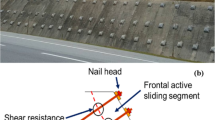Abstract
Enhancing the strength of retaining structure with soil nails and prestressed anchors is a new technique that can be used in the excavation of deep foundation pit. Finite element analysis (FEA) based on ABAQUS is presented in this paper to investigate the failure mechanism of such retaining structure. The model used in the FEA is firstly validated by comparing the modelled results with field measurements for a specific case. The model is then extended to investigate the influence of the prestressed anchor on the (1) horizontal deformation of foundation pit and (2) the distribution of axial forces along the soil nails. It is found that the magnitude of anchor force is the key factor governing the performance of the entire retaining system. However, the influence of the prestressed anchor is sensitive to the rigidity of the concrete surface layer of the retaining structure. Based on the results of the modelling, the failure mechanism of soil nail—prestressed anchor composite retaining structure is discussed.

















Similar content being viewed by others
References
ABAQUS User’s and Theory Manuals (1992) Version 5.2, Hibbit, Karlson & Sorensen Inc., Pawtucket, RI
Barrett C, Zhang R, Rock A (2013) Advances in design methodology for landslide repair using launched soil nails. In: Geo-congress 2013, ASCE, pp 1811–1820
Brown PT, Booker JR (1985) Finite element analysis of excavation. Res. Rep. No. 532, School of Civil and Mining Engineering, University of Sydney, Sydney, Australia
Carbonell JM, Onate E, Suarez B (2010) Modeling of ground excavation with the particle finite-element method. J Eng Mech 136(4):455–463
Chandrasekaran VS, King GJW (1974) Simulation of excavation using finite elements. ASCE J Geotechnol Eng Div 100(9):1086–1089
Cheuk CY, Ng CWW, Sun HW (2005) Numerical experiments of soil nails in loose fill slopes subjected torainfall infiltration effects. Comput Geotech 32:290–303
Christian JT, Wong IH (1973) Errors in simulating excavation in elastic media by elements. Soils Found 13:1–10
Clough GW (1984) User’s manual for program soil struct. Department of Civil Engineering, Virginia Polytechnic Institute and State University, Blacksburg
Davies MCR (2010) The performance of soil nailed systems. Int Symp Ground Improv Technol Case Hist 2010:107–121
Fernandes MM, Falcao JCB (1988) The nonlinear behaviour of ground anchors and its consideration in finite element analysis of tie-back walls. In: Proceedings of the numerical methods in geomechanics, Balkema, Rotterdam, The Netherlands, pp 1243–1248
FHWA (1996) Manual for design and construction monitoring of soil nail walls. Rep. No. FHWA-SA-96-069, Washington, DC
Garg A, Garg A, Tai K (2014) An integrated SRM-multi-gene genetic programming approach for prediction of factor of safety of 3-Dsoil nailedslopes. Eng Appl Artif Intell 30:30–40
Helwany S (2007) Applied soil mechanics with ABAQUS applications. Wiley, New York
Hsiao PC, Lehman DE, Roeder CW (2012) Improved analytical model for special concentrically braced frames. J Constr Steel Res 73:80–94
Kim NK, Briaud J-L (1994) A beam column method for tieback walls. Rep. to Schnabel Foundation and the Federal Highway Administration, Department of Civil Engineering, Texas A&M University, College Station, TX
Lian Z, Han G, Lv K (2002) Elastoplastic numerical analysis and stability study of soil-nailed wall. Rock Soil Mech 23(1):85–89 (In Chinese)
Lim Y, Briaud J-L (1996) Three dimensional nonlinear finite element analysis of tieback walls and of soil nailed walls under piled bridge abutment. Rep. to the Federal Highway Administration and the Texas Department of Transportation, Department of Civil Engineering, Texas A&M University, College Station, TX
Mitchell JK, Christopher BR (1990) North American practice in reinforced soil systems, Spec. Tech. Publ. No. 25. ASCE, New York, pp 322–346
Mitchell JK, Villet WCB (1987) Reinforcement of earth slopes and embankments. NCHRP Rep. No. 290, Transportation Research Board, Washington, DC
Nazir R, Loon WT, Niroumand H (2013) An investigation of anchored steel pile wall as a retaining structure in slope stability. Geotech News 31(3):42–45
Nguyen KL, Treyssede F (2015) Numerical investigation of leaky modes in helical structural waveguides embedded into a solid medium. Ultrasonics 57:125–134
Pradhan B, Tham LG, Yue ZQ, Junaideen SM, Lee CF (2006) Soil–nail pullout interaction in loose fill materials. Int J Geomech ASCE 6(4):238–247
Qin S, Hong JIA, Ping MA et al (2005) Numerical analysis of deformation and failure in prestressed soil-nailed reinforcement structure. Rock Soil Mech 26(9):1356–1362 (In Chinese)
Qin H, Li F, Guo Y (2013) Three-dimensional finite-element analysis of panel installation of a ultra-deep diaphragm wall. Chin J Geotech Eng 35(s2):335–340 (In Chinese)
Silveira RAM, Nogueira CL, Goncalves PB (2013) A numerical approach for equilibrium and stability analysis of slender arches and rings under contact constraints. Int J Solids Struct 50(1):147–159
Wood DV (1990) Soil behavior and critical state soil mechanics. Cambridge University Press, London
Author information
Authors and Affiliations
Corresponding author
Rights and permissions
About this article
Cite this article
Wang, H., Cheng, Jh., Guo, Yc. et al. Failure Mechanism of Soil Nail—Prestressed Anchor Composite Retaining Structure. Geotech Geol Eng 34, 1889–1898 (2016). https://doi.org/10.1007/s10706-016-9998-5
Received:
Accepted:
Published:
Issue Date:
DOI: https://doi.org/10.1007/s10706-016-9998-5




